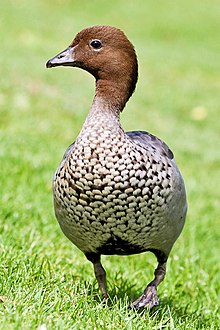Swimming ducks
| Swimming ducks | ||||||||||
|---|---|---|---|---|---|---|---|---|---|---|

Mallard -pair ( Anas platyrhynchos ) |
||||||||||
| Systematics | ||||||||||
|
||||||||||
| Scientific name | ||||||||||
| Anatini | ||||||||||
| Leach , 1820 |
The swimming ducks ( Anatini), also called green ducks , are the most species-rich tribe of the duck birds (Anatidae). They include the mallard - the trunk form of the domestic duck and the most famous of all ducks.
features
Typically, male swimming ducks are very gorgeous, while females are inconspicuously colored in shades of brown. During the moult, the males briefly adapt to the females in terms of coloration. Exceptions to this are the tropical duck species, which often do not show any seasonal dimorphism. In these, the sexual dimorphism is often not very pronounced. Examples of this are red-billed ducks , amber ducks and laysan ducks . The phenomenon also occurs, albeit rarely, in duck species that are found in cold climates. An example of this is the kerguelen duck that inhabits subarctic islands in the Pacific.
distribution and habitat
Swimming ducks are found on all continents except Antarctica and in all climatic zones from the Arctic to the tropics. All species inhabit fresh water, some species only reach the coasts by migration . They rely on shallow waters because of their deep diet.
Way of life
The food of the swimming ducks are seeds, aquatic plants and invertebrates, which are obtained either from the surface of the water or from the bottom of the water. The animals most commonly eaten by swimming ducks are mosquito larvae, water beetles, caddis fly larvae, dragonfly larvae, water bugs and mayfly larvae, as well as snails and water fleas to a lesser extent.
Swimming ducks can dive, but very rarely use this skill. During the pounding, only the rear end protrudes from the water, while the bird searches for something to eat in the ground. An exception are the wigeons , which mainly look for their food on land and eat grasses and herbs for geese. The shovelers have a reshaped beak, the fine lamellae of which are specialized in feeding plankton.
Like most ducks, swimming ducks are monogamous, but only until the end of the breeding season. The mallard drake leaves the female shortly after laying the eggs.
Systematics
In the past, the glossy ducks were placed next to the swimming ducks as a separate tribus; they have meanwhile been dissolved and integrated into the swimming ducks. In contrast, some deviating genera are no longer part of the swimming ducks (see the system of duck birds ).
The following genera and species are classified according to Kear 2005 and Gonzalez et al. 2009 counted among the ducks. The division into subtribes is based on Livezey 1991:
- Subtribe Cairinina
- Genus Cairina
- Musk duck , Cairina moschata
- Genus Asarcornis
- White-winged duck , Asarcornis scutulata (and sometimes Cairina expected)
- Genus Pteronetta
- Hartlaub's Duck , Pteronetta hartlaubii
- Genus Aix
- Wood duck , Aix sponsa
- Mandarin duck , Aix galericulata
- Genus Cairina
- Subtribe nettapodina
- Genus Chenonetta
- Maned Goose , Chenonetta jubata
- Genus dwarf ducks , nettapus
- African pygmy duck , Nettapus auritus
- Coromandel pygmy duck , Nettapus coromandelianus
- Australian pygmy duck , Nettapus pulchellus
- Genus Chenonetta
- Subtribe Anatina
- Genus Amazonetta
- Amazon duck , Amazonetta brasiliensis
- Genus real ducks ( Anas ) (31 species)
- Genus Callonetta
- Red-shouldered Duck , Callonetta leucophrys
- Genus Lophonetta
- Crested Duck , Lophonetta specularioides
- Genus Mareca
- North American wigeon ( Mareca americana )
- Sickle duck ( Mareca falcata )
- Amsterdam ( Mareca marecula ), extinct
- Pfeifente ( Mareca Penelope )
- Chiloé Wigeon ( Mareca sibilatrix )
- Schnatterente ( Mareca strepera )
- Genus Sibirionetta
- Baikalente ( Sibirionetta formosa )
- Genus shoveler ( spatula )
- Cinnamon ( Spatula cyanoptera )
- Shoveler ( Spatula clypeata )
- Blue-winged duck ( Spatula discors )
- Hottentot Duck ( Spatula hottentotta )
- Australian shoveler ( Spatula rhynchotis )
- Cape shoveler ( Spatula smithii )
- Fox Shoveler ( Spatula platalea )
- Puna duck ( Spatula puna )
- Teal duck ( spatula querquedula )
- Versicolorente ( Spatula versicolor )
- Speculanas genus
- Copper mirror duck , Speculanas specularis
- Genus Amazonetta
literature
- Janet Kear (Ed.): Ducks, Geese and Swans. Oxford University Press, 2005, ISBN 0-19-854645-9 .
Individual evidence
- ↑ Gonzalez, J .; Düttmann, H .; Wink, M. (2009). Phylogenetic relationships based on two mitochondrial genes and hybridization patterns in Anatidae. Journal of Zoology. 279: 310-318. doi: 10.1111 / j.1469-7998.2009.00622.x
- ^ Bradley C. Livezey : A phylogenetic analysis and classification of recent dabbling ducks (tribe Anatini) based on comparative morphology . In: Auk 1991, No. 108, pp. 471-508




